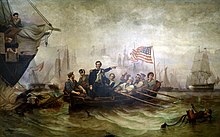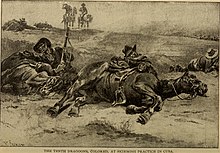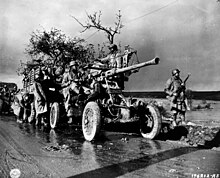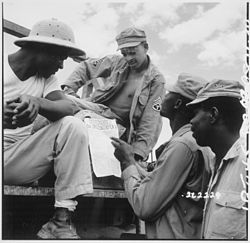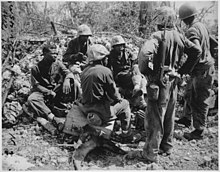Military history of African Americans
African Americans also served with various of the South Carolina guerrilla units, including that of the "Swamp Fox", Francis Marion,[4] half of whose force sometimes consisted of free Blacks.
Martin served with the Marine platoon on the Reprisal for a year and a half and took part in many ship-to-ship battles including boardings with hand-to-hand combat, but he was lost with the rest of his unit when the brig sank in October 1777.
Hannibal Collins, a freed slave and Oliver Hazard Perry's personal servant, is thought to be the oarsman in William Henry Powell's Battle of Lake Erie.
The only exception to this Army policy was Louisiana, which gained an exemption at the time of its purchase through a treaty provision, which allowed it to opt out of the operation of any law, which ran counter to its traditions and customs.
Victory in this war marked the emergence of America as a world power, ousting Spain from Cuba and Puerto Rico, and taking over former Spanish possessions in the Pacific of Guam, Hawaii and the Philippines.
[33] This conflict also holds a vital place in the military history of African-Americans, since African Americans could then enlist as full-fledged members of the U.S.Navy, were considered sailors, and performed a wide array of duties onboard ship.
"At that time [1898] as it had been since the Continental Navy in the American Revolution [1775], Black sailors were an integral part of the crew," said Rear Admiral Sam Cox, director of Naval History and Heritage Command, in a speech commemorating the 125th anniversary of the Maine.
When the Maine catastrophically exploded in Havanna Harbor on Feb. 15, 1898 under mysterious circumstances, 260 Navy men drowned or died within hours from severe injuries from the blast – twenty-two of them from the African-American crew.
The National Association for the Advancement of Colored People (NAACP) had been formed in 1909 to move Black equality of opportunity forward, but with the declaration of war in 1917 civil rights leader W.E.B.
Secretary of War Newton D. Baker had made it clear that, though African Americans would be fairly treated in the military, the department could not "undertake at this time to settle the so-called race question.
For example Marvin Kirk, a 21 year old African American man with no wife or children, who did not seek exemption from the draft and was in good health, did not get called up for service until August 11, 1917.
[50] It was also common for African American men to face disputes for them to be drafted during WW1, from White Southern planters, opposing on the grounds that it would affect their regional agricultural economy by removing labourers and allowing them to serve in the war instead.
The YMCA work provided entertainment, recreation, and education to the vast majority of African American troops as they had more time on their hands since they served in labor battalions.
Black US soldiers failed to escape from the arm of Jim Crow whilst they were serving in World War I, and domestically, their fellow African Americans faced the same discrimination within the US.
[94] Even Doris Miller, the valiant Navy mess attendant, who, with no military training at all, grabbed an anti-aircraft weapon and started blasting away at Japanese aircraft bombing Pearl Harbor until he ran out of ammunition, felt the sting of racial injustice despite his instant fame.
Several Sailors of this era reported a similar story of their contribution to fighting in the conflict being overlooked in history such as Steward's Mate, 2nd class James Killebrew, who manned a 20mm gun onboard the USS Tennessee and helped defend the boat from attacking aircraft in the battles of Leyte Gulf, Iwo Jima, and Okinawa.
While still Stewards, those in the submarine fleet also served as ammunition passers, were assigned to gun crews, manned the helm, bow, or stern planes, and assisted with reloading torpedoes.
They also reported more camaraderie with their white counterparts due to submarine crews' close proximity with each other in daily operation, unlike the surface vessel black sailors who faced extreme prejudice.
By the end of the war, the 761st were known as Patton's Panthers; they had been in combat for 183 continuous days, fought in four major Allied campaigns in six different countries, starting with the Battle of the Bulge, and had inflicted more than 130,000 casualties on the enemy.
The actual combat deaths tallied is under a thousand [109] but the casualties inflicted in war include from more than deaths in battle; they include the missing, the captured, succumbing to illnesses in war-related places like malaria in the jungle, proximity to explosives handled by truckers and stevedores, aerial bombing, terrible burns from oil fires in hangars and on decks, drowning in torpedoed ships with young "Messmen" deep in the galley – with 2 million African-Americans serving in every theater of the war, the true casualty rate is surely in the thousands.
A blue plaque commemorating the contribution of African-American soldiers based in Wales during World War II was installed by the Nubian Jak Community Trust at RAF Carew Cheriton on the 75th anniversary of the D-Day landings, June 6, 2019.
The best-known work of the Quartermaster Corps in World War II was the brief Red Ball Express, which ferried food, supplies and fuel along the rapid advance of Allied forces from the Normandy Invasion to the incursion into Germany.
Six thousand trucks operating 24 hours a day, most with two African American drivers on circular routes carried 400,000 tons of supplies through increasingly liberated Europe between August 25 and November 16, 1944.
However, the Quartermaster units assigned to this grim duty did so with dignity, creating simple grave-markers in clear spaces, often quietly standing by the graves, the only mourners when a fallen soldier is laid to rest.
[175] The House Committee on Military Affairs held hearings in response to the press crusade, issuing a report in 1946 that sharply criticized its use and the VA for discriminating against blue discharge holders.
[179] Judge William Hastie, the civilian aide for race relations in the war department, received thousands of letters which detailed the bad treatment of African American troops.
In 1950, Lieutenant Leon Gilbert of the still-segregated 24th Infantry Regiment was court martialled and sentenced to death for refusing to obey the orders of a white officer while serving in the Korean War.
"Every military commander", the Directive mandates, "has the responsibility to oppose discriminatory practices affecting his men and their dependents and to foster equal opportunity for them, not only in areas under his immediate control, but also in nearby communities where they may gather in off-duty hours.
Civil-rights leaders protested this disparity during the early years of the war, prompting reforms that were implemented in 1967–68 resulting in the casualty rate dropping to slightly higher than their percentage of the total population.
[187][188][189][190] In 1967, President Lyndon B. Johnson presented the Medal of Honor to U.S. Army Specialist Five Lawrence Joel, for a "very special kind of courage – the unarmed heroism of compassion and service to others."


